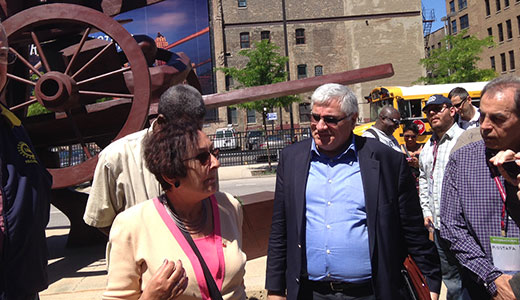
CHICAGO – Some of the 300 delegates and guests of the Communist Party USA’s 30th Convention kicked off their party’s gathering here this weekend with a labor history tour of the Windy City.
They said the tour was an appropriate way of starting deliberations because Chicago is the place where May Day began, where the Communist Party was first founded, and it was the launching point for a nationwide strike for the eight hour day. The first stop on the tour was the exact place where the battle for that day came to a dramatic turning point – Haymarket Square, specifically, the memorial dedicated to the Haymarket martyrs.
Tour host Tim Yeager, a United Auto Workers union organizer and Episcopal priest at St. Andrew’s parish, explained that the Federation of Organized Trades and Labor Unions (predecessor of the American Federation of Labor) called on May 1, 1886 for a nationwide movement for the eight-hour work day. “Eight hours for work, eight hours for rest, eight hours for what we will,” went the slogan, according to Yeager. The rally that kicked off the movement went on to influence the history of labor worldwide, he said. “It started with German immigrant August Spies and his best friend Albert Parsons.
“On that day,” said Yeager, “80,000 workers marched arm-in-arm down Chicago’s Michigan Avenue, led by Albert and August. This was the first national flexing of power by people in the U.S. labor movement. The following day, Albert went to Ohio to organize rallies there while his wife Lucy organized a peaceful second march in Chicago of 35,000 workers.”
The scene turned violent the following day, when Chicago police attacked and killed picketing workers at the McCormick plant at Western and Blue Island Avenues. The attack provoked a protest meeting at Haymarket Square on May 4. “Some 2,500 people showed up,” he said. “The meeting was delayed somewhat, as Lucy Parsons had organized a separate meeting of sewing workers in Geneva, Illinois. The last-minute speakers to arrive were Albert Parsons and English-born Samuel Fielden. The meeting was almost over when they were confronted by 176 policemen carrying Winchester repeater rifles.
“Suddenly, someone threw a bomb. The police panicked and shot at their own men in the ensuing confusion.” The next day, the Chicago incident was used as an excuse to crush local union movements. Chicago labor leaders were rounded up and arrested, houses were searched without warrants and progressive newspapers were shut down. But there was no attempt made to find the actual bomber. Eventually eight men, the Haymarket martyrs, were selected to be tried. Among them were Fielden and Parsons.
Labor historians note that during the trial, the jury was totally biased. Seven of the leaders were sentenced to die, and the other, Oscar Neebe, was sentenced to 15 years in prison.”
What came to be called the Haymarket Affair, or perhaps more appropriately, the Haymarket Massacre, of course took on an international dimension in July 1889 when a delegate from the American Federation of Labor recommended at a labor conference in Paris that May 1 be set aside as International Labor Day, or “May Day,” in memory of the martyrs and the injustice they faced.
As the history lesson continued, our tour next took a turn west, just outside of Chicago, to a cemetery in Forest Park lush with greenery and nature. In the peaceful and quiet surrounding tour goers browsed and explored the graves of people including the “Rebel Girl” Elizabeth Gurley Flynn and Emma Goldman. But the most important cite in the cemetery was the centerpiece of the labor history embedded there: the Haymarket Martyrs’ Monument, which depicts a woman standing over the body of a fallen worker and marching onward to continue the fight. It was declared a national historic landmark in 1997.
“This cemetery,” mused Yeager, “has probably a greater concentration of working class history than anywhere else on the planet. This has become a place of pilgrimage for workers all over the world. It became a place where others in the labor movement wanted to have their resting place. Here also lie the graves of many other communists, socialists, and anarchists. Nearby are family members of the martyrs, including Lucy Parsons.”
As the tour concluded, he remarked, “In the last letter to his wife, August said, ‘Undertake no rash acts because of my death. Simply pick up the mantle and move forward.’ And so she did.”
Photo: Labor history tour participants stop at Haymarket Square. Michelle Kern/PW












Comments